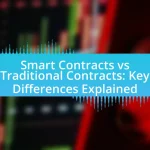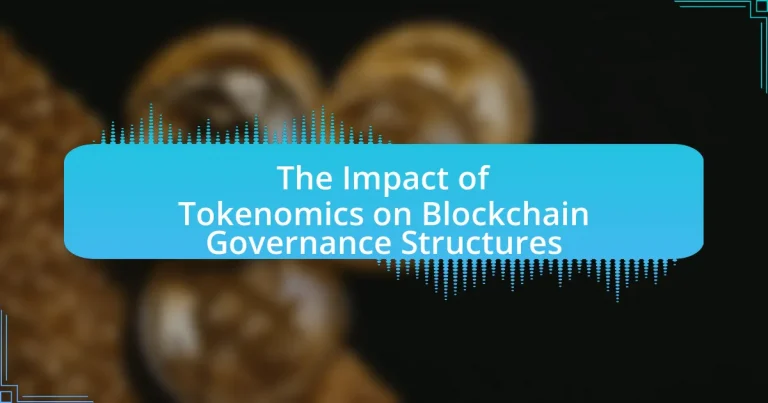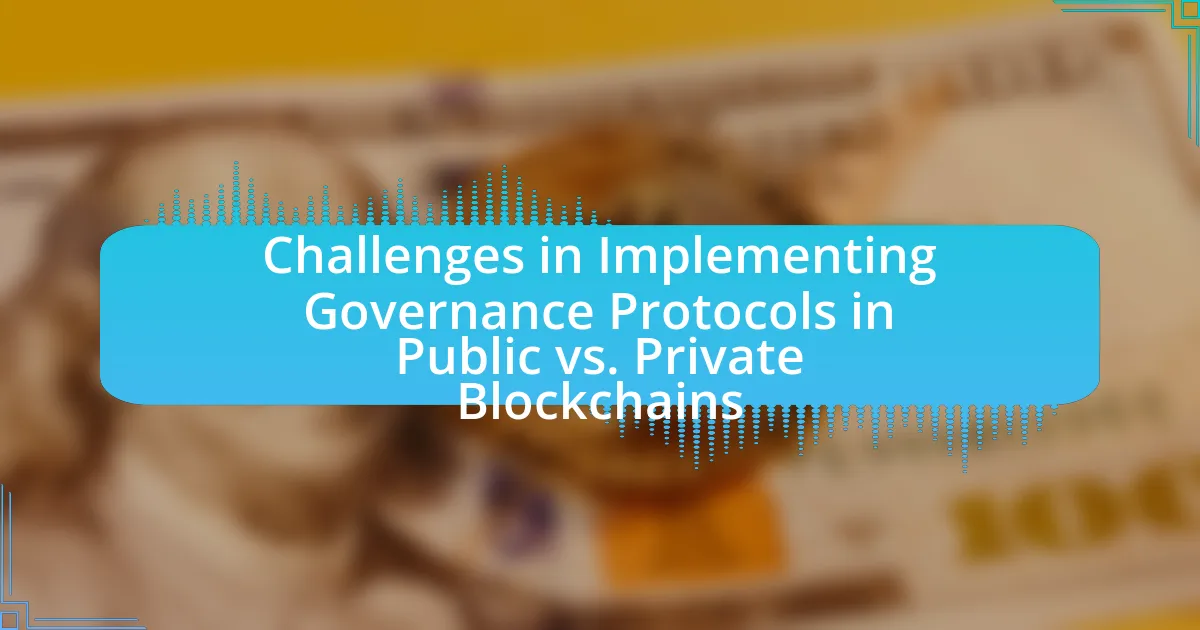Tokenomics plays a crucial role in shaping blockchain governance structures by influencing token distribution, utility, and stakeholder incentives. The article examines how effective tokenomics can enhance participation, align interests, and establish decision-making mechanisms within decentralized networks. Key components such as token distribution models, governance rights associated with utility tokens, and the impact of governance tokens are discussed, highlighting their significance in promoting community engagement and effective governance. Additionally, the article addresses challenges like centralization and misalignment of incentives, proposing solutions to improve tokenomics for better governance outcomes in blockchain ecosystems.
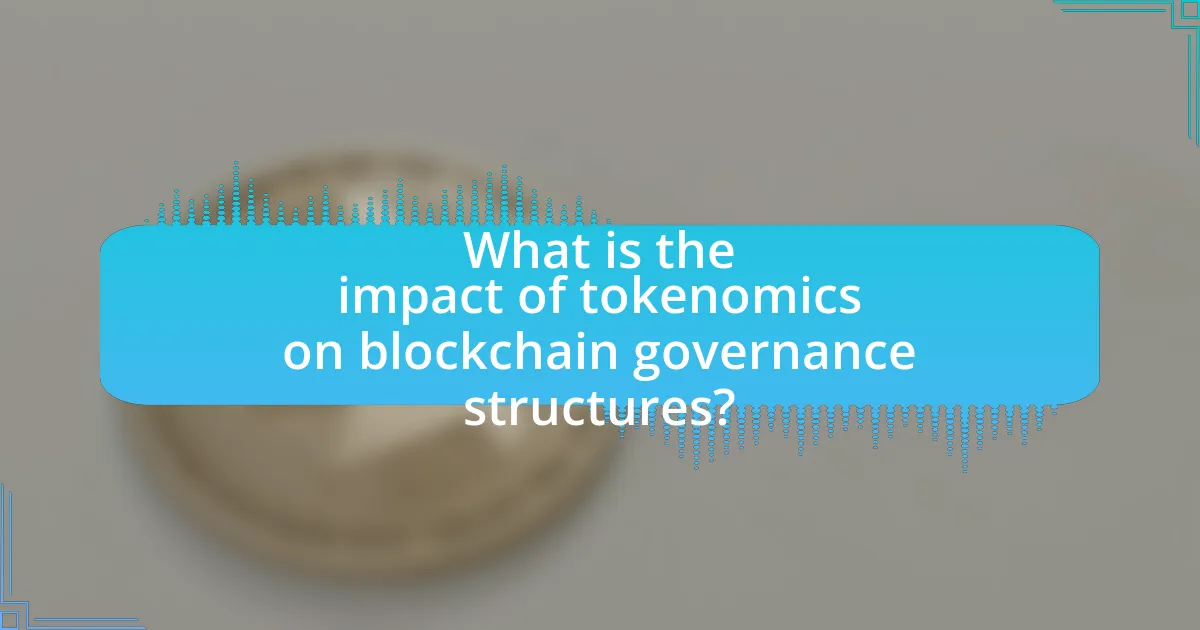
What is the impact of tokenomics on blockchain governance structures?
Tokenomics significantly influences blockchain governance structures by determining how tokens are distributed, utilized, and governed within a network. The design of tokenomics can incentivize participation, align stakeholder interests, and establish mechanisms for decision-making. For instance, projects like Ethereum utilize a proof-of-stake model where token holders can vote on governance proposals, thereby directly impacting the network’s evolution. This model illustrates how tokenomics can create a participatory governance framework, enhancing decentralization and community engagement. Additionally, research indicates that effective tokenomics can lead to increased network security and stability, as seen in successful projects that have implemented robust governance models tied to their token structures.
How does tokenomics influence decision-making in blockchain governance?
Tokenomics significantly influences decision-making in blockchain governance by determining the distribution and utility of tokens, which directly impacts stakeholder incentives and participation. The design of tokenomics, including aspects such as token supply, allocation, and governance rights, shapes how stakeholders engage with the network and make decisions. For instance, a study by Catalini and Gans (2016) highlights that token holders with greater voting power are more likely to influence governance outcomes, thereby aligning their interests with the network’s success. This alignment is crucial as it encourages active participation and investment in the ecosystem, ultimately affecting the overall governance structure and its effectiveness.
What are the key components of tokenomics that affect governance?
The key components of tokenomics that affect governance include token distribution, utility, and incentives. Token distribution determines how tokens are allocated among stakeholders, influencing their voting power and participation in governance decisions. Utility refers to the functional use of tokens within the ecosystem, which can drive engagement and influence governance participation. Incentives, such as rewards for active participation or penalties for inactivity, motivate stakeholders to engage in governance processes. These components collectively shape the governance structure by defining who has power, how decisions are made, and the level of stakeholder engagement, ultimately impacting the effectiveness and legitimacy of governance in blockchain systems.
How do token distribution models shape governance participation?
Token distribution models significantly influence governance participation by determining who holds decision-making power within a blockchain ecosystem. For instance, models that favor early investors or large stakeholders can lead to centralized governance, where a few individuals or entities dominate decision-making processes. Conversely, models that promote wider distribution, such as airdrops or community incentives, encourage broader participation and democratize governance, allowing more voices to influence outcomes. Research indicates that decentralized governance structures, supported by equitable token distribution, enhance community engagement and trust, ultimately leading to more resilient and adaptive governance systems.
Why is tokenomics essential for effective governance in blockchain networks?
Tokenomics is essential for effective governance in blockchain networks because it establishes the economic incentives and disincentives that guide participant behavior. By defining how tokens are distributed, utilized, and valued, tokenomics directly influences stakeholder engagement and decision-making processes. For instance, a well-structured tokenomics model can encourage active participation in governance through mechanisms like staking, where users lock their tokens to vote on proposals, thereby aligning their financial interests with the network’s success. Additionally, research indicates that networks with clear tokenomics frameworks, such as Ethereum and its transition to proof-of-stake, demonstrate enhanced governance efficiency and community involvement, leading to more robust and adaptive governance structures.
What role do incentives play in governance through tokenomics?
Incentives play a crucial role in governance through tokenomics by aligning the interests of stakeholders with the overall objectives of a blockchain network. Tokenomics utilizes economic incentives, such as rewards and penalties, to motivate participants to act in ways that enhance network security, promote decentralization, and ensure active participation in governance processes. For instance, in decentralized finance (DeFi) platforms, token holders are often rewarded with governance tokens that grant them voting rights, thereby encouraging them to engage in decision-making that benefits the ecosystem. This alignment is supported by empirical evidence, such as the success of protocols like MakerDAO, where token incentives have led to increased user engagement and effective governance outcomes.
How does tokenomics enhance community engagement in governance?
Tokenomics enhances community engagement in governance by providing financial incentives for participation and decision-making. Through mechanisms such as staking, voting rewards, and token distribution, community members are motivated to actively engage in governance processes. For instance, projects like MakerDAO utilize tokenomics to allow MKR token holders to vote on key protocol changes, directly linking their financial stake to governance outcomes. This alignment of economic interest fosters a more involved and responsible community, as members are more likely to participate when their financial well-being is tied to the governance decisions made.

What are the different types of tokenomics models used in blockchain governance?
The different types of tokenomics models used in blockchain governance include utility tokens, security tokens, and governance tokens. Utility tokens provide access to a product or service within a blockchain ecosystem, while security tokens represent ownership in an asset and are subject to regulatory oversight. Governance tokens enable holders to participate in decision-making processes, influencing protocol changes and upgrades. For instance, platforms like Ethereum utilize governance tokens to allow stakeholders to vote on proposals, thereby directly impacting the network’s evolution. These models are essential for aligning incentives among participants and ensuring effective governance in decentralized systems.
How do utility tokens impact governance structures?
Utility tokens significantly influence governance structures by enabling token holders to participate in decision-making processes. These tokens often grant voting rights on proposals, protocol changes, and resource allocation, thereby decentralizing authority and enhancing community engagement. For instance, in decentralized finance (DeFi) platforms like MakerDAO, holders of the MKR token can vote on critical governance issues, directly impacting the platform’s operations and policies. This mechanism fosters a sense of ownership among users and aligns their interests with the platform’s success, as their voting power is proportional to their token holdings. Consequently, utility tokens serve as a vital tool for implementing decentralized governance, promoting transparency, and ensuring that stakeholders have a voice in the ecosystem’s evolution.
What are the governance rights associated with utility tokens?
Governance rights associated with utility tokens typically include the ability to participate in decision-making processes regarding the development and management of a blockchain project. Holders of utility tokens may vote on proposals, influence protocol upgrades, and determine the allocation of resources within the ecosystem. For instance, in projects like Ethereum, token holders can vote on changes to the network, reflecting their stake in the platform’s future. This participatory mechanism is essential for decentralized governance, as it empowers users to shape the direction of the project based on their interests and investment.
How do utility tokens facilitate user participation in governance?
Utility tokens facilitate user participation in governance by granting holders voting rights and influence over decision-making processes within a blockchain ecosystem. These tokens often enable users to propose changes, vote on protocol upgrades, and participate in community discussions, thereby ensuring that governance is decentralized and reflective of the user base’s preferences. For instance, in platforms like Ethereum, holders of governance tokens can vote on critical issues such as network upgrades or changes to fee structures, directly impacting the platform’s future. This mechanism not only empowers users but also aligns their interests with the success of the network, as their stake in the token often correlates with their voting power.
What is the role of governance tokens in blockchain ecosystems?
Governance tokens play a crucial role in blockchain ecosystems by enabling holders to participate in decision-making processes regarding the protocol’s development and governance. These tokens grant voting rights on proposals, such as changes to the protocol, allocation of funds, and other significant governance matters. For instance, in decentralized finance (DeFi) platforms like MakerDAO, governance tokens allow users to vote on critical issues, ensuring that the community has a say in the platform’s evolution. This mechanism fosters decentralization and aligns the interests of token holders with the long-term success of the ecosystem, as their voting power directly influences the direction of the project.
How do governance tokens differ from other token types?
Governance tokens differ from other token types primarily in their function, as they grant holders the ability to participate in decision-making processes within a blockchain ecosystem. Unlike utility tokens, which provide access to a service or product, or security tokens, which represent ownership in an asset, governance tokens empower users to vote on proposals, changes, and upgrades to the protocol. For instance, holders of governance tokens like Maker (MKR) can influence the direction of the MakerDAO platform by voting on key issues, demonstrating their unique role in decentralized governance. This participatory mechanism is essential for maintaining the decentralized nature of blockchain projects, as it aligns the interests of token holders with the overall health and direction of the network.
What mechanisms do governance tokens use to enable voting?
Governance tokens enable voting through mechanisms such as on-chain voting, off-chain voting, and quadratic voting. On-chain voting allows token holders to participate directly in decision-making by submitting votes that are recorded on the blockchain, ensuring transparency and immutability. Off-chain voting, often facilitated through platforms or forums, allows for discussions and consensus-building before formal voting occurs, although it may lack the same level of security as on-chain methods. Quadratic voting empowers users to express the intensity of their preferences by allowing them to allocate multiple votes to a single option, thereby reflecting the strength of their opinions rather than just a binary choice. These mechanisms collectively enhance decentralized governance by providing diverse methods for token holders to influence protocol decisions.
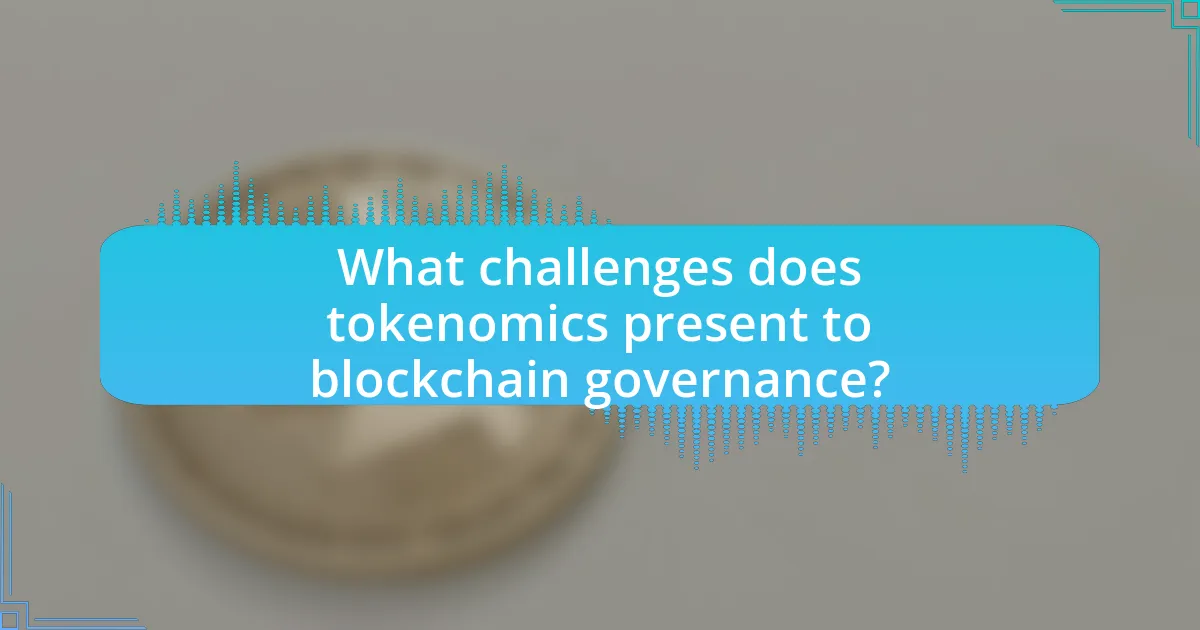
What challenges does tokenomics present to blockchain governance?
Tokenomics presents several challenges to blockchain governance, primarily through issues of centralization, misalignment of incentives, and regulatory compliance. Centralization occurs when a small group of token holders can exert disproportionate influence over governance decisions, undermining the decentralized ethos of blockchain. Misalignment of incentives arises when the interests of token holders diverge from the long-term health of the network, leading to decisions that prioritize short-term gains over sustainable growth. Regulatory compliance challenges stem from the evolving legal landscape surrounding cryptocurrencies, which can create uncertainty and hinder effective governance. These challenges can disrupt the intended democratic processes of blockchain governance, as evidenced by instances where governance proposals favored large stakeholders at the expense of broader community interests.
How can token concentration affect governance outcomes?
Token concentration can significantly skew governance outcomes by enabling a small group of token holders to exert disproportionate influence over decision-making processes. When a majority of tokens are held by a limited number of individuals or entities, these holders can effectively control voting mechanisms, leading to decisions that may not reflect the broader community’s interests. For instance, in the case of the DAO hack in 2016, a concentrated token distribution allowed a few participants to dominate governance decisions, ultimately resulting in a controversial hard fork. This illustrates how token concentration can undermine the democratic principles intended in decentralized governance structures, as it creates an imbalance that favors the interests of a few over the collective will of the many.
What are the risks of centralization in tokenomics?
Centralization in tokenomics poses significant risks, primarily including reduced security, increased susceptibility to manipulation, and diminished trust among participants. When a small group controls the majority of tokens, they can influence decisions disproportionately, leading to governance that does not reflect the broader community’s interests. This concentration of power can result in decisions that prioritize the interests of a few over the many, undermining the foundational principles of decentralization that blockchain technology aims to uphold. Historical examples, such as the governance issues faced by projects like Bitconnect, illustrate how centralization can lead to catastrophic failures and loss of user confidence.
How can governance structures mitigate the effects of token concentration?
Governance structures can mitigate the effects of token concentration by implementing mechanisms such as quadratic voting, delegation of voting power, and multi-signature wallets. Quadratic voting allows users to express the intensity of their preferences, reducing the influence of large token holders. Delegation enables smaller token holders to assign their voting rights to trusted representatives, thus balancing power dynamics. Multi-signature wallets require multiple approvals for decisions, preventing unilateral actions by concentrated token holders. These mechanisms have been observed in various blockchain projects, such as the Ethereum community’s use of quadratic voting in governance proposals, demonstrating their effectiveness in promoting equitable decision-making.
What are the potential solutions to improve tokenomics in governance?
Potential solutions to improve tokenomics in governance include implementing mechanisms for better incentive alignment, enhancing liquidity, and introducing dynamic governance models. Incentive alignment can be achieved by ensuring that token holders have a vested interest in the long-term success of the project, which can be facilitated through staking rewards or profit-sharing models. Enhancing liquidity involves creating more accessible trading options and liquidity pools, which can attract a broader base of participants and stabilize token value. Dynamic governance models, such as quadratic voting or delegated voting, can empower a more diverse range of stakeholders and ensure that governance reflects the interests of the community. These approaches have been supported by various blockchain projects that have successfully implemented similar strategies, demonstrating their effectiveness in improving governance outcomes.
How can innovative token models enhance governance effectiveness?
Innovative token models can enhance governance effectiveness by enabling decentralized decision-making and incentivizing participation among stakeholders. These models often incorporate mechanisms such as staking, voting rights, and rewards that align the interests of token holders with the overall success of the governance structure. For instance, projects like MakerDAO utilize a governance token that allows holders to vote on critical protocol changes, ensuring that those who are most invested in the ecosystem have a say in its direction. This participatory approach not only increases engagement but also leads to more informed and representative decision-making, as evidenced by the high voter turnout in governance proposals, which can exceed 50% in active communities.
What best practices can be adopted for equitable token distribution?
Equitable token distribution can be achieved through several best practices, including implementing a fair allocation model, ensuring transparency in the distribution process, and engaging the community in decision-making. A fair allocation model, such as a proportional distribution based on contributions or participation, helps prevent centralization of tokens among a few holders. Transparency in the distribution process, such as publicly sharing distribution metrics and methodologies, fosters trust and accountability. Engaging the community allows for diverse input and can lead to more equitable outcomes, as seen in projects like Ethereum, where community feedback shaped governance decisions. These practices collectively promote fairness and inclusivity in token distribution, essential for sustainable blockchain governance.
What practical strategies can blockchain projects implement for effective tokenomics in governance?
Blockchain projects can implement several practical strategies for effective tokenomics in governance, including establishing clear utility for tokens, incentivizing participation, and ensuring transparency in decision-making processes. Clear utility for tokens encourages users to engage with the platform, as seen in projects like Ethereum, where Ether is used for transaction fees and smart contract execution. Incentivizing participation can be achieved through reward mechanisms, such as staking or governance voting rewards, which have been successfully utilized by projects like Tezos, promoting active community involvement. Transparency in governance, exemplified by projects like Aragon, allows stakeholders to understand decision-making processes and fosters trust, ultimately leading to a more engaged and informed community. These strategies collectively enhance the effectiveness of tokenomics in governance structures within blockchain projects.

